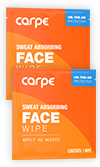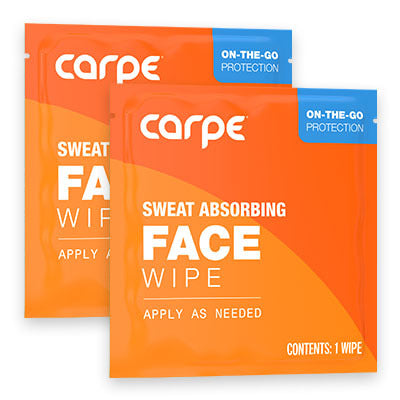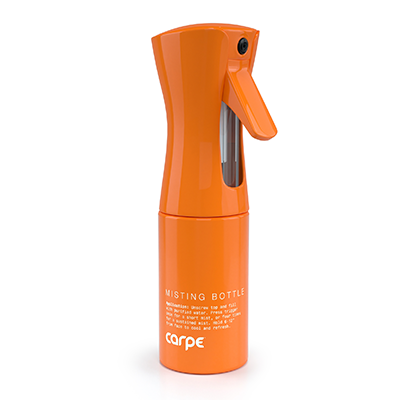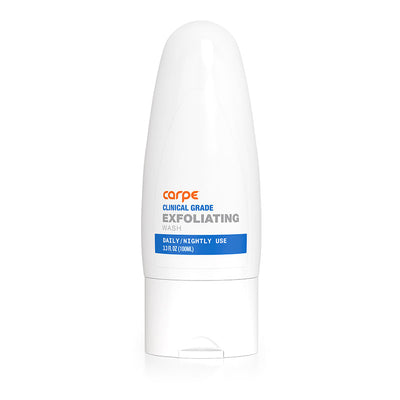Glycopyrrolate and Oxybutynin: The Sweat Pill
If you’ve been thinking about taking medication to help you stop sweating excessively you may have heard about a drug called Glycopyrrolate and Oxybutynin.
Meditations like glycopyrrolate and oxybutynin are often used in conjunction with localized treatments to tackle sweat.
THE GIST:
- Glycopyrrolate and Oxybutynin are both anticholinergic medicines used to treat hyperhidrosis, a skin condition that causes excessive sweating.
- You have to have a prescription to get these medications.
- Neither Glycopyrrolate or oxybutynin are specifically approved by the FDA for the treatment of excessive sweating. They are used off label.[1]
THE DIFFERENCES?
Glycopyrrolate:

Glycopyrrolate (sold under the brand name Robinul) is one of the anticholinergics used most often in the treatment of hyperhidrosis, although this varies widely between doctors and studies.
Here’s what you should know about glycopyrrolate:
- Usually pill form
- General directions are 1 to 2 mg twice a day
- Many times patients are limited in the amount of glycopyrrolate they are able to take due to side effects that increase as the dose increases.
- Glycopyrrolate has a high cost for those without insurance.[2]
- There are several possible side effects, which include:
- Dry mouth (the most common side effect)
- Dry eyes
- Constipation
- Nausea
- Many others
Drinking more water, mints, eye-drops and increased fiber consumption might help fight these side effects.[1]
The effectiveness of glycopyrrolate is often related to the dose a patient is able to handle.
One study on the effectiveness of glycopyrrolate found that out of 19 patients 80% responded to treatment. However, one third of the patients had to stop treatment due to side effects.[1]
Other studies have found that the drug is effective in reducing sweating but that side effects often hinder treatment.
Glycopyrrolate is often chosen as a second, or third line therapy for hyperhidrosis that causes excessive sweating of the palms, soles, and armpits.
It is one of the first line treatments for craniofacial hyperhidrosis.[3]
Many times, using glycopyrrolate in conjunction with other therapies increases the success rate.[1]
Oxybutynin

Oxybutynin (brand name Ditropan) is the other most commonly used anticholinergic used in the treatment of hyperhidrosis.
Here’s what you need to know about oxybutynin:
- Available in several forms. Pill (5-10mg daily for most, but up to 15-20mg), topical gel, slow-release tablet, transdermal patch
- Oxybutynin has similar side effects as glycopyrrolate. However, it is able to penetrate into the central nervous system (CNS) more easily so it can also have some added CNS side effects.[1]
- The additional side effects include:
- Constipation
- Drowsiness
- Confusion
- Others[4]
- It is relatively inexpensive.[2]
Oxybutynin is found to be effective in treating the symptoms of hyperhidrosis but, like other anticholinergic drugs, side effects often get in the way.
One study of 50 patients using oxybutynin to treat palmar and axillary hyperhidrosis found that 70% of patients reported improvements in those areas. Interestingly, 90% of the patients also reported improvement of plantar sweating.
Side effects were noted as moderate to severe in 35% of the patients by the six week mark of the study.[1]
This indicates that oxybutynin is effective in reducing sweat production, but that, when used orally it can be limited by the side effects it can cause.
Another study found that 60% of their patients showed improvement in their quality of life compared to only 27% in the placebo group, when low doses of oxybutynin were given.[4]
What are Anticholinergic Medications?
Here’s the Science Behind How They Work:
Anticholinergics agents comprise a group of medications that work by affecting how the body is able to use the neurotransmitter acetylcholine.
A neurotransmitter is a type of chemical messenger the brain and spinal cord use to communicate. Specifically, anticholinergics interrupt acetylcholine from being used at certain receptors (muscarinic receptors) throughout the body by binding with it.

Muscarinic receptors are located throughout the autonomic nervous system (one of the peripheral nervous systems), and spread out over the whole body, which is why anticholinergics are responsible for such widespread effects.[1]
The autonomic nervous system is the part of the nervous system that controls involuntary actions, like the movement of the GI tract muscle, breathing, heart rate, and many other functions.[5] It is also responsible for regulating sweat production, which is why anticholinergic medications can be useful in the treatment of hyperhidrosis.[1]
There are several types of anticholinergics, although most are not used in the treatment of hyperhidrosis.
Glycopyrrolate and Oxybutynin are the two most common anticholinergic medications used to treat excessive sweating.
While there are other anticholinergics that can be used to treat hyperhidrosis, they are not available in the United States.
The most studied anticholinergic agent, other than glycopyrrolate and oxybutynin, is called methantheline bromide, and it has had some promising results in Germany.[1]
Local Treatments that Use Glycopyrrolate and Oxybutynin
All oral medications for hyperhidrosis will cause side effects that affect the whole body because of how they work.
This can often make them less desirable treatment options. Sometimes, this is necessary, like in the case of a patient who has generalized all-over sweating instigated by a medication that causes hyperhidrosis as a side effect.[1]
However, both glycopyrrolate and oxybutynin are available in other forms that allow them to be used locally.
Both drugs are available to be used in conjunction with an iontophoresis machine when being used to treat palmar and plantar hyperhidrosis.
The electrical current from the iontophoresis machine aids the skin in absorbing the medications locally.[5]
Topical creams are available containing both medications but their effectiveness is currently unclear as the medications may have trouble penetrating the skin barrier in this form.
A new product called Qbrexza uses glycopyrrolate on a medicated wipe that can be used once a day to prevent sweating.[1]
Future Uses in the Treatment of Hyperhidrosis
There are various future treatments and research for hyperhidrosis that involve the use of both glycopyrrolate and oxybutynin.
The most notable of these future treatments is the use of glycopyrrolate in a topical form which would be able to penetrate into eccrine glands.
The cream would contain 1% or 2% glycopyrrolate.
Oxybutynin is also being studied and potentially developed into a topical cream.
Researchers are also looking into developing a glycopyrrolate pad to relieve sweating symptoms.[1]
For those who are interested in medicated antiperspirant wipes, but who don’t want to deal with prescription medications like Qbrexza, there are now over-the-counter antiperspirant wipes available from brands like Carpe.
If you aren’t sure that taking a pill is right for you, then you might want to consider trying a clinical strength antiperspirant product.
Recently, Carpe has come out with a product line called Carpe Clinical Regimen that can tackle even the most stubborn underarm sweat.
Sources
- Pariser, D. M. (2014). Hyperhidrosis (4th ed., Vol. 32). Philadelphia, PA: Elsevier. Retrieved from https://www.elsevier.com/books/hyperhidrosis-an-issue-of-dermatologic-clinics/pariser/978-0-323-32607-0
- Huddle, J. R. (2014). Hyperhidrosis: Causes, Treatment Options and Outcomes. New York, NY: Nova Science. Retrieved from https://novapublishers.com/shop/hyperhidrosis-causes-treatment-options-and-outcomes/
- Walling, H., & Swick, B. L. (2011). Treatment Options for Hyperhidrosis. . American Journal of Clinical Dermatology, 12(5), 285-295. Retrieved September 5, 2018, from https://pubmed.ncbi.nlm.nih.gov/21714579/
- Dahl, M. V. (2016). Oxybutynin for Hyperhidrosis. NEJM Journal Watch. Dermatology. doi:10.1056/nejm-jw.NA39817. Retrieved from https://www.jwatch.org/na39817/2016/01/14/oxybutynin-hyperhidrosis
- Autonomic nervous system. (2018). Retrieved September 6, 2018, from https://www.merriam-webster.com/dictionary/autonomic nervous system
- Qbrexza. (2018). Retrieved February 20, 2019, from https://dermira.com/our-medicines/




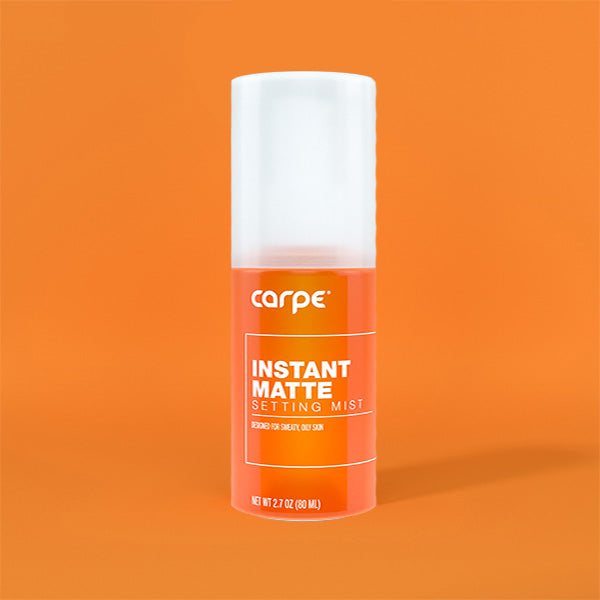

16790753702383.jpg?v=1679075372)

16790746985853.jpg?v=1679074700)


16790757289763.jpg?v=1679075731)





